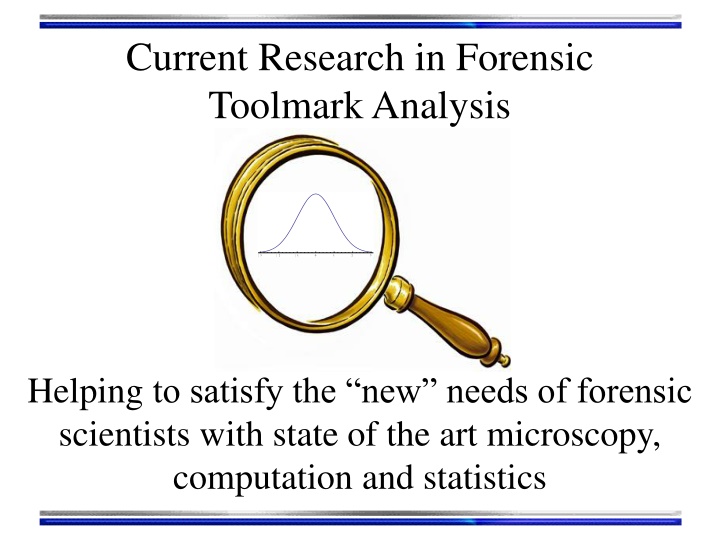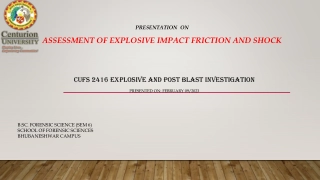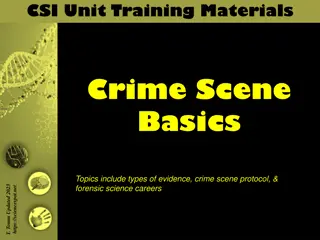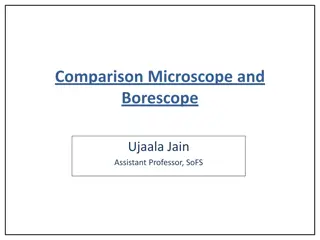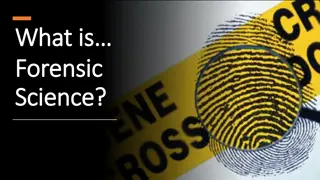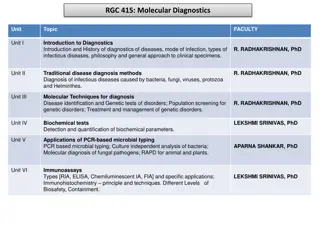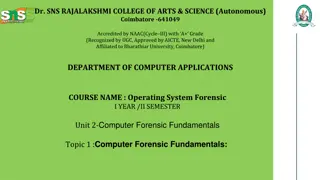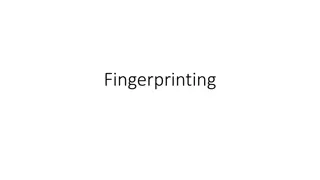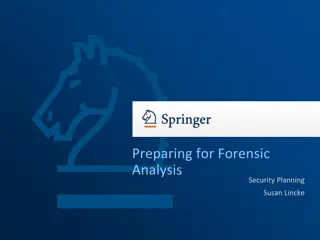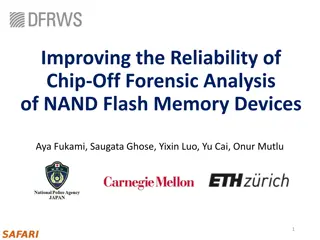Current Research in Forensic Toolmark Analysis
Cutting-edge research in forensic toolmark analysis leveraging state-of-the-art microscopy, computation, and statistics to meet the evolving needs of forensic scientists. Explore topics like 3D toolmark analysis, quantitative criminalistics, data acquisition for toolmarks, machine learning applications, statistical pattern comparison, and more.
Download Presentation

Please find below an Image/Link to download the presentation.
The content on the website is provided AS IS for your information and personal use only. It may not be sold, licensed, or shared on other websites without obtaining consent from the author.If you encounter any issues during the download, it is possible that the publisher has removed the file from their server.
You are allowed to download the files provided on this website for personal or commercial use, subject to the condition that they are used lawfully. All files are the property of their respective owners.
The content on the website is provided AS IS for your information and personal use only. It may not be sold, licensed, or shared on other websites without obtaining consent from the author.
E N D
Presentation Transcript
Current Research in Forensic Toolmark Analysis 3 2 1 0 1 2 3 Helping to satisfy the new needs of forensic scientists with state of the art microscopy, computation and statistics
Outline Introduction Instruments for 3D toolmark analysis 3D toolmark data The statistics: Identification Error Rates Match confidence Match probability Statistics from available practitioner data
Quantitative Criminalistics All forms of physical evidence can be represented asnumerical patterns o Toolmark surfaces o Dust and soil categories and spectra o Hair/Fiber categories and spectra o Craniofacial landmarks o Triangulated fingerprint minutiae Machine learning trains a computer to recognize patterns o Can give the quantitative difference between an identification and non-identification Moran o Can yield identification error rate estimates o May be even confidence measures for I.D.s
Data Acquisition For Toolmarks Confocal Microscope Comparison Microscope Scanning Electron Microscope Focus Variation Microscope
Screwdriver Striation Patterns in Lead 3D surfaces (interactive) 2D profiles
Bullets Bullet base, 9mm Ruger Barrel Bullet base, 9mm Glock Barrel
What can we do with all this microscope data? Statistical pattern comparison! Modern algorithms are called machine learning Idea is to measure features that characterize physical evidence Train algorithm to recognize major differences between groups of features while taking into account natural variation and measurement error.
Visually explore: 3D PCA of 760 real and simulated mean profiles of primer shears from 24 Glocks: ~45% variance retained
Support Vector Machines Support Vector Machines (SVM) determine efficient association rules In the absence of specific knowledge of probability densities SVM decision boundary
18D PCA-SVM Primer Shear I.D. Model, 2000 Bootstrap Resamples Refined bootstrapped I.D. error rate for primer shear striation patterns= 0.35% 95% C.I. = [0%, 0.83%] (sample size = 720 real and simulated profiles)
How good of a match is it? Conformal PredictionVovk Can give a judge or jury an easy to understand measure of reliability of classification result Confidence on a scale of 0%-100% Testable claim: Long run I.D. error- rate should be the chosen significance level Cumulative # of Errors 80% confidence 20% error Slope = 0.2 This is an orthodox frequentist approach Roots in Algorithmic Information Theory 95% confidence 5% error Slope = 0.05 99% confidence 1% error Slope = 0.01 Data should be IID but that s it Sequence of Unk Obs Vects
Conformal Prediction For 95%-CPT (PCA-SVM) confidence intervals will not contain the correct I.D. 5% of the time in the long run Straight-forward validation/explanation picture for court Empirical Error Rate: 5.3% Theoretical (Long Run) Error Rate: 5% 14D PCA-SVM Decision Model for screwdriver striation patterns
How good of a match is it? Efron Empirical Bayes An I.D. is output for each questioned toolmark This is a computer match What s the probability the tool is truly the source of the toolmark? Similar problem in genomics for detecting disease from microarray data They use dataandBayes theorem to get an estimate
A Bayesian Hierarchical Model: Believability Curve JAGS MCMC Bayesian over-dispersed Poisson with intercept, on test set
Bayes Factors/Likelihood Ratios In the Forensic Bayesian Framework , the Likelihood Ratio is the measure of the weight of evidence. LRs are called Bayes Factors by most statistician LRs give the measure of support the evidence lends to the prosecution hypothesis vs. the defense hypothesis From Bayes Theorem: ( ) ) Pr Hp|E Pr Hd|E ( Pr Hp Pr Hd ( ( ( ) )= LR =Pr E | Hp Pr E | Hd =Posterior Odds Prior Odds ( ) )
Bayes Factors/Likelihood Ratios Using the fit posteriors and priors we can obtain the likelihood ratiosTippett, Ramos Known match LR values Known non-match LR values
Available Large Scale Practitioner Studies Two large scale published studies o 10-Barrel TestHamby: o 626 practitioners (24 countries) o 15 unknowns per test set o At least one bullet from each of the 10 consecutively manufactured barrels o # examiner errors committed = 0 o GLOCK Cartridge Case TestHamby: o 1632 9-mm Glock fired cartridge cases o 1 case per Glock o All cartridge cases pair-wise compared o # of pairs of cartridge cases judged to have enough surface detail agreement to be (falsely) matching = 0 o AFTE Theory of Identification standard used: www.swggun.org
Available Large Scale Practitioner Studies So does that mean the error rate is 0%? 0% error rate is the frequentist estimate oWe looked to sports statistics for low scoring games o Bayesian statistics provide complementary methods for analysis oCan work much better in estimating small probabilities
Available Large Scale Practitioner Studies For 10-Barrel we need to estimate a small error rate For GLOCK we need to estimate a small random match probability (RMP) Use Bayesian Beta-binomial method when no failures are observed (Schuckers)
Available Large Scale Practitioner Studies Basic idea of the reverend Bayes: Prior Knowledge Data = Updated Knowledge Error Rate/RMP = + Uninf( , ) Beta-Binomial(data | , ) Posterior( , | data) Get updated estimates of Error rate/RMP
Available Large Scale Practitioner Studies So given the observed data and assuming prior ignorance o Posterior error rate/RMP distributions: Posterior Distribution of RMP, 1632 Cartridge Cases Posterior Dist. GLOCK Posterior Distribution of Average Examiner Error Rate for 626 Participants Posterior Dist. 10-Barrel 400 RMP Average Examiner Error Rate 0.011% [0.00023%, 0.040%] 300 300 0.000086% Frequency Frequency [0.0000020%, 0.00031%] 200 100 100 0 0 0e+00 0.00 0.02 0.04 0.06 0.08 0.10 2e 04 4e 04 6e 04 8e 04 RMP (%) Error Rate (%)
Acknowledgements Professor Chris Saunders (SDSU) Professor Christophe Champod (Lausanne) Alan Zheng (NIST) Research Team: Dr. Martin Baiker Ms. Helen Chan Ms. Julie Cohen Mr. Peter Diaczuk Dr. Peter De Forest Mr. Antonio Del Valle Ms. Carol Gambino Dr. James Hamby Dr. Peter Pizzola Dr. Graham Rankin Dr. Jacqueline Speir Dr. Peter Shenkin Ms. Rebecca Smith Mr. Chris Singh Mr. Peter Tytell Ms. Elizabeth Willie Ms. Melodie Yu Dr. Peter Zoon Ms. Alison Hartwell, Esq. Dr. Thomas Kubic, Esq. Ms. Loretta Kuo Ms. Frani Kammerman Dr. Brooke Kammrath Mr. Chris Lucky Off. Patrick McLaughlin Dr. Linton Mohammed Mr. Nicholas Petraco Dr. Dale Purcel Ms. Stephanie Pollut
